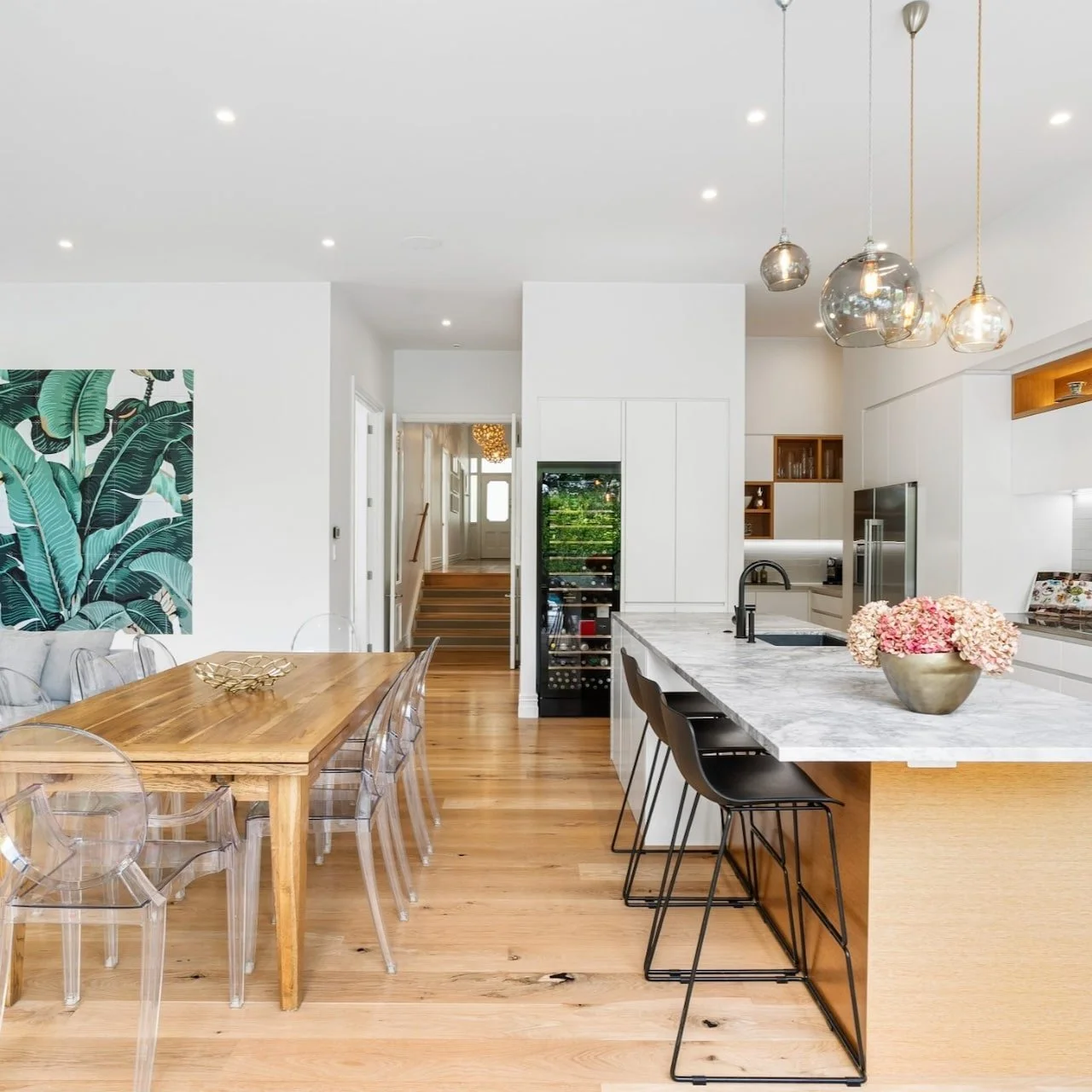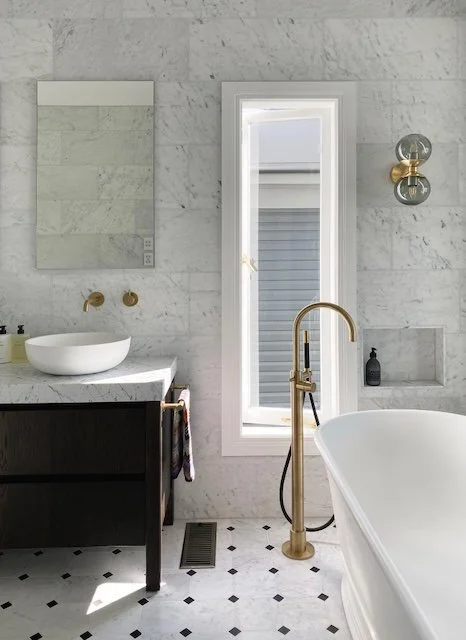Interior lighting made easy
A Guide to Feature & General Lighting
An easy way to enhance your home is to design a well thought out lighting plan. In addition to brightening up a space, carefully selected lighting has the ability to emphasize unique architectural elements, showcase special decor pieces, and establish the perfect ambiance for every occasion.
Start exploring lighting design by learning about some of the many lighting choices available.
Types of lighting for your home
Every lighting source in your home can be categorised as general, task, or accent lighting.
General lighting, also known as ambient lighting, serves as the primary illumination for a room. This category includes both installed light fixtures and natural light entering through skylights or windows.
Accent lighting is designed to highlight certain areas within a room, such as a reading chair, kitchen island, dining table, or a piece of artwork. It focuses on these elements, providing sufficient light to showcase them without overwhelming the surrounding space.
Task lighting involves the use of fixtures and lamps to illuminate work areas. Examples include a desk lamp for office paperwork, vanity lights for applying makeup, or a light above the sink for dishwashing. Some lights may fall into multiple categories, such as kitchen island lights serving as both accent and task lighting, or track lights functioning as either general or accent lighting.
By layering different types of lighting, you can add dimension and depth to a room.
⬆️ General & feature Lighting
Pendant lights can add a touch of style and personality to an open plan kitchen/dining room while also providing general lighting. Here, these are placed over the dining table and kitchen island. To light spaces in between, there are recessed ceiling LEDs strategically placed and on dimmers.
Note there is also LED task lighting under the cupboards, above the bench, at the back of the kitchen.
⬆️ Task & Accent Lighting
An LED bathroom mirror is both a task and an accent light in this space.
This type of mirror can be turned off and on with a push button on the front face. The temperature of the light (warm or cool) and brightness can also be adjusted.
In this bathroom there is also an under vanity LED light on a sensor which provides soft lighting so that it isn’t necessary to use the overhead lights when using the bathroom during the night.
Photo from Pinterest
⬆️ Task & General lighting
Table lamps can be used to provide general lighting in a living room, or they can be used to create accent lighting in specific areas. They can also be positioned to provide task lighting for reading. They are great just to create ambience in a living area with their soft lighting.
⬆️ Task & Accent Lighting
Pendant lights can be used over kitchen islands, workbenches, or craft tables to provide focused task lighting.
They also act as an accent light and can be an important aesthetic part of the overall design. A special pendant light can even be the focal point of a whole room and can set the design aesthetic accordingly.
⬆️ Wall Sconces
Wall sconces can provide both general and task lighting.
They can be used to create a decorative accent in a room (as in these photos above).
They can be used to highlight artwork or other features.
Recessed LED Downlights
Recessed LED lights, also known as downlights, are popular for modern interiors due to their sleek design and energy efficiency. Installed into the ceiling, they provide a clean and unobtrusive lighting solution that can enhance any space. However, it's essential to understand their pros and cons, and how best to use and place them in your home to maximize their benefits and avoid common pitfalls.
There are a number of different sizes and functions for LED downlights. These one are from Switch Lighting
LED Pros & Cons
Recessed LED lights offer several advantages. They are energy-efficient, consuming significantly less power than traditional incandescent bulbs, which helps reduce electricity bills and environmental impact. Additionally, LEDs have a much longer lifespan, often lasting up to 50,000 hours, which reduces the frequency and cost of replacements. Their space-saving design allows them to fit flush with the ceiling, providing a clean, modern look that doesn't clutter the room. Recessed lights are also versatile, available in various color temperatures and beam angles, making them suitable for different lighting needs, from ambient to task lighting. Many LED recessed lights are dimmable, allowing you to adjust the light levels to suit different moods and activities. We would advise to always select a dimmable fitting if possible.
However, there are some drawbacks to consider. Installing recessed lights can be more complex and costly than other types of lighting, needing professional installation and sometimes requiring ceiling modifications if retro fitting into an existing home. Proper heat management is also necessary to prevent overheating and ensure the longevity of the LEDs. Additionally, it's easy to install too many recessed lights, leading to an overly bright and unflattering effect.
To use recessed LED lights effectively, consider layering your lighting by combining them with other types of lights, such as pendant lights, wall sconces, and floor lamps, to create a balanced and layered lighting scheme. Focus on functionality by using recessed lights to highlight specific areas or tasks, such as over kitchen benches, reading nooks, or workspaces. Choose the right trim and housing to match the style of your home and the purpose of the lighting. A simple white fixture that blends into the ceiling is the look we prefer. Installing dimmer switches is a must (in our opinion) and allows you to adjust the light intensity. For example, while you may need a brightly lit kitchen when preparing a meal, you might want to dim the lights once you are eating at the table or relaxing in the space afterwards.
When determining LED placement, avoid scattering lights randomly across the ceiling (we try to avoid the Swiss cheese look!). Instead, place them about 1.2 to 1.8 metres apart and approximately 60-90cm from the walls to create even lighting without over-saturating the space. Focus on key areas that require direct light, such as work surfaces, reading areas, and walkways. Position lights to minimize shadows and glare; for instance, in the kitchen, place lights above the front edge of countertops to prevent shadows cast by people working at the counter. Use recessed lights to accentuate architectural features, artwork, or focal points in a room, enhancing the overall aesthetic without overpowering the space.
Don’t go crazy with the downlights!
Avoid the temptation to install too many recessed lights, which can lead to an overly bright and unflattering environment. Instead, focus on strategic placement and supplement with other light sources to ensure balanced and consistent brightness throughout the room. There is nothing that looks less considered than a space with only an abundance of downlights and no other lighting sources.
Recessed LED lights are a versatile and energy-efficient lighting option that can significantly enhance the look and functionality of your home. The key is to strike a balance and avoid overuse, ensuring that your lighting enhances rather than overwhelms your interior design.
Lighting Temperature Guide
Which Light Temperature Works Best in Your Home?
Light bulb temperatures are measured in Kelvin (K) and most homes feature light bulbs that are in the 2,000K to 5,500K range. While the scale spans from 1,000K to 10,000K, neutral tones are around 4,000K to 4,100K. Temperatures below 4,000K shine warmer and temperatures above 4,100K glow cooler.
Colour temperature preferences are subjective, but here are some suggestions to help you begin. Opt for soft, warm lights in spaces such as bedrooms, dens, and family rooms to create an inviting and comfortable ambiance.
For areas that require bright and clear illumination, like kitchens, bathrooms, or spaces where attention to detail is crucial, people usually prefer to use bright or neutral white bulbs. Be sure not to go too far up the scale towards the cool temperatures or spaces can tend to feel a bit clinical.
Reserve daylight bulbs for locations or workspaces that benefit from extra bright lighting, such as garages, basements, or areas with vanities.
It is possible to visit certain lighting suppliers and view their lights at various temperatures, in a darkened room. This is a great way to see which temperature you prefer. This is something our clients have found really helpful.
Lightbulb Options
Different Bulb Choices & understanding popular options
Choosing the right bulb can feel like navigating a maze, with various options vying for your attention. Let's demystify some of the most common types and their applications.
Light-Emitting Diode (LED)
Reigning supreme in popularity, LEDs are champions of longevity and efficiency. With a lifespan exceeding 25,000 hours, this means you'll change them much less than their shorter-lived counterparts. Plus, they use significantly less energy, translating to lower bills and a greener footprint. Their versatility shines through, adapting to recessed ceiling lights, hanging pendants, track lighting, and even smart home systems. Whether you desire warm or cool tones, adjustable brightness, or even color-changing fun, LEDs have you covered. However, be prepared for a slightly higher initial cost, and remember that colour rendering can vary depending on quality.
Compact Fluorescent (CFL)
While popularity wanes compared to LEDs, Compact Fluorescent Lamps (CFLs) still hold their own in some areas. They boast impressive energy efficiency and extended lifespans, making them ideal for desk lamps, utility lights, and task lighting. They offer a decent range of colour temperatures, but their bulkier size and the presence of mercury (requiring special disposal) are drawbacks. Additionally, the slow start-up time and occasional flicker might not be everyone's cup of tea.
Incandescent
Remember the warm glow of traditional incandescent bulbs? While their charm persists, their lower efficiency and short lifespans compared to LEDs and CFLs push them towards a more decorative role. Think string lights, table lamps, and pendants where ambiance reigns supreme. They're readily available and affordable, but be prepared for higher energy bills and frequent replacements.
Halogen
If you crave crisp, bright light, Halogen bulbs might catch your eye. They excel in track lighting, recessed downlights, and spotlights, offering excellent colour rendering and a feel reminiscent of incandescents. However, their energy efficiency falls short of LEDs, and their shorter lifespan and higher heat output make them a less sustainable choice.
Smart Bulbs
Step into the future with Smart Bulbs! You can control your lighting via app, changing colours, setting schedules, and integrating them into your smart home ecosystem. The convenience and customization options are undeniable, but be prepared for a higher initial investment. Smart bulbs can be adapted to various fixtures, making them a versatile choice for those seeking a tech-savvy lighting experience.
Solar Powered
Embrace sustainability with Solar-powered Bulbs. Perfect for outdoor string lights, garden lights, and pathway lights, they harness the sun's energy, eliminating the need for wiring and reducing your carbon footprint. However, remember their limited lumen output and dependence on weather conditions.
Follow this lighting series for more useful tips on how best to light your home.
Part 1: LED lighting for bathrooms
If you found these tips valuable, stay connected for more exclusive insights, inspirations, and behind-the-scenes peeks into the world of interior design.
All photos of interiors in this article are spaces designed by Suzanne Allen Design











